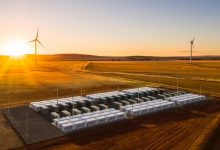French-based renewable energy developer Neoen says it expects the Tesla big battery at its Hornsdale facility will deliver even more savings this coming summer because of the role it will play in boosting the transfer limits to South Australia.
The Tesla big battery, officially known as the Hornsdale Power Reserve, celebrated its first anniversary earlier this month, releasing modelling that showed it had delivered $40 million in savings from just the FCAS (frequency control) market in its first 12 months.
Those savings do not include any savings delivered through its activity in the wholesale electricity market, where it is likely to have clipped the peaks traditionally dominated and exploited by the gas and diesel generators.
Its presence has already meant the elimination of a key grid constraint that was cynically exploited by the gas generators, and in a few weeks the presence of the Tesla big battery will help enable AEMO to deliver its long-mooted increase of capacity of the key Heywood inter-connector to 650MW from 600MW (from Victoria to South Australia).
That upgrade that was put on hold after the system black in 2016, but is now being rolled out under the newly developed System Integrity Protection Scheme, to help ensure that the lights stay on in the case of any major event such as a transmission failure of coal unit trip.
Neoen says the battery is playing a key roll in that scheme, although it should be noted, however, that an AEMO spokeswoman said all facilities are required to meet the requirements of the SIPS. She also noted that a final date for the network upgrade has not been decided.
Neoen said SIPS are increasingly utilised in energy systems around the world to provide additional power transfer capacity and enhanced operational security. HPR contributes to AEMO’s and ElectraNet’s SIPS, which reduces the chance of the Heywood Interconnector overloading when multiple generators disconnect within South Australia.
The new SIPS, which is contributed by HPR free of charge, is specifically designed to further support electrical interconnectors between South Australia and other states. The capacity limits on interconnectors are set below the physical limit because of system stability issues – the SIPS increases system stability, allowing capacity limits to be lifted.
“At its core, the new interconnection limit will bolster competition within the South Australian electricity market by increasing interstate trade,” the Neoen statement says.
“This reduces wholesale power prices and subsequently creates a knock-on effect on end-user charges across the state.” Neoen puts the savings in “the millions of dollars per year.”
Franck Woitiez, the head of Neoen Australia, said in a statement it was “another prime example of how innovative, forward-looking and advanced renewable energy technology, when combined with storage, has the power to significantly drive down electricity prices for consumers across the country.
“These savings are just the beginning of what is to come with the planned new large interconnector between South Australia and New South Wales,.”










